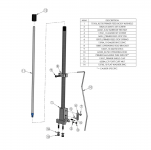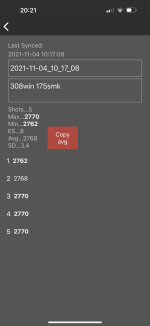About to pull the trigger on a Dillon progressive reloader. I am reloading for semi-auto rifles (except for the 9mm which is handgun only). I've read through dozens of threads and found these particularly useful so yes, I've done some reading/research:
Lucked into a Dillon XL750 setup in 223/556 with case feeder. I plan on loading 556,762, 7mm rem mag, 357 mag, and 9mm to start. What accessories/parts should I purchase? I have already purchased a mr. bullet feeder, case feeder plates, Hornady Reloading manual, and a swageit. I plan on running...

www.snipershide.com
When I got into reloading earlier this year I purchased a single stage because I thought it would meet my needs and I was unsure of jumping directly into using a progressive. I am now on track to load 4K+ precision rifle rounds a year and want to make the jump to a Dillon 550C because I'd rather...

www.snipershide.com
I am reloading for the following and already have dies for them:
-9mm
-300 Blackout
-5.56
-.308
Because I want to reload in bulk for 9mm, and I have use for large and small primers with the rifle rounds, I’m considering the XL750 over the 550. I’ve even considered just getting the 550 basic, perhaps even two of them. My goal is to eliminate the massive time suck I’ve created in reloading for the semi-auto rifles. It’s not unusual for me to reload 500 at a time over the course of a few days.
I am aiming for practical precision and hunting, not shooting out to 1,000 yards out of a bolt gun (yet). I’ll keep my single stage if I really need to be precise and work up to that on the Dillon.
Here’s my current process for rifle using an RCBS single stage press.
-Short wet tumble with stainless media
-Dry in dehumidifier
-Decap with universal decapping die
-Swage with a Dillon Super Swage 600 when needed (I use a lot of Lake City brass)
-Ream and unify when I really want to torture myself. Otherwise just a quick ream on an RCBS to make the primers go in easier
-Anneal
-Lube and full length resize using Hornady custom grade dies
-Set neck tension with Century 21 mandrel
-Trim to length if needed on a Giraud
-Longer wet tumble with stainless media
-Dry in dehumidifier
-Prime with Franklin hand-held
-Measure powder with either an RCBS Chargemaster 1500 or use an RCBS thrower or Lee thrower depending on powders used and if load is developed.
-Seat bullet with a Hornady seater and micrometer
-Crimp in separate step with a Redding crimp die
This has worked well for me in terms of the quality I’ve been able to produce. I know I could likely do an initial longer tumble and forget about cleaning primer pockets. I may go that route. I haven’t really looked but are there rifle full length resizing dies with a primer punch but without the neck expander ball? That’d eliminate a separate step right there.
I currently use the following powders with the caliber in parenthesis:
-H335 (5.56)
-Benchmark (5.56)
-IMR 4064 (7.62)
-Varget (7.62)
-CFE Blk (300 Blackout)
-Lil Gun (300 Blackout)
-H110 (300 Blackout)
-VV N120 (300 Blackout)
-VV N340 (9mm)
-Alliant Sport Pistol (9mm)
I get really good results with the Lee thrower and the extruded powders like Varget. Anything that’s ball, non-extruded, goes through the RCBS thrower although I have not tried all the powders above through the RCBS or Lee throwers just yet. I will likely simplify my powders and stick to one for each cartridge if I’m able but like the flexibility depending on availability.
**I am going to separate brass processing and reloading into two different steps on the Dillon.**
**I almost never load more than one caliber in a “session”. I may load up say 300 .308 cartridges with a single stage and will move on to something else at a later time. So setup time isn’t a major factor but it is a factor.
One quick question, when ordering the XL750 from Dillon, you must specify a cartridge. Is there any advantage in ordering one over another? My most pressing needs (I see what you did there) are 300 blackout and 9mm.
I don’t want to go overboard with add ons that I may not make a difference based on my practical accuracy requirement. I don’t have an unlimited budget and want to keep it smart. I may try out the Dillon products first and want to keep my dies preset. If they don’t work for me, I’ll look towards the aftermarket, toolheads not included. With that said, here’s what I’d like to order from Dillon;
-XL750 basic kit
-Extra primer tubes for small/large
-Caliper conversion kits for the other three cartridges
-Powder dies (3) so I can swap over the powder measure between tool heads
-Bullet tray
-Possibly the RT1500 trimmer, short trim toolhead and rapid trim size/trim die
I am willing to make mods/adjustments to the powder drop system (polish everything) and the priming system which I know can also be a hangup. I'm also willing to move the powder measuring step off-press if need be.
Aftermarket in no particular order;
-Inline Fab locator pin tabs
-Inline Fab Ultramount
-Inline Fab ERGO roller lever
-Uniquetek powder tube baffle
-Uniwquetek Powder bar micrometer (assuming I just need one if swapping out the powder measure
-Uniquetek powder measure quick change, QD Tab
-Billet tool heads, possibly floating die variety like Armanov, for each caliber
-Shellplate bearing kit (like Hit Factor) which’ll come in hand with 300BLK supers especially
-Possibly the Area 419 master funnel kit if I’m dropping manually
-KMS LED light kit
What else might I need to swap the powder system from tool head to tool head easily? I’ll eventually add more but would like to save a few $$$ initially by moving it from toolhead to toolhead.
Anything else that might be absolutely necessary? I’m sure I’ve left some stuff out as there’s a lot to consider and you don’t always know what you don’t know until you’re hands on.







